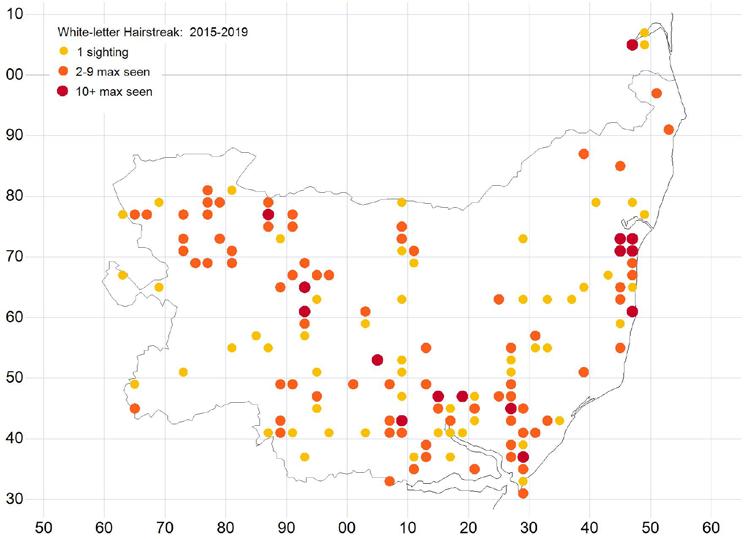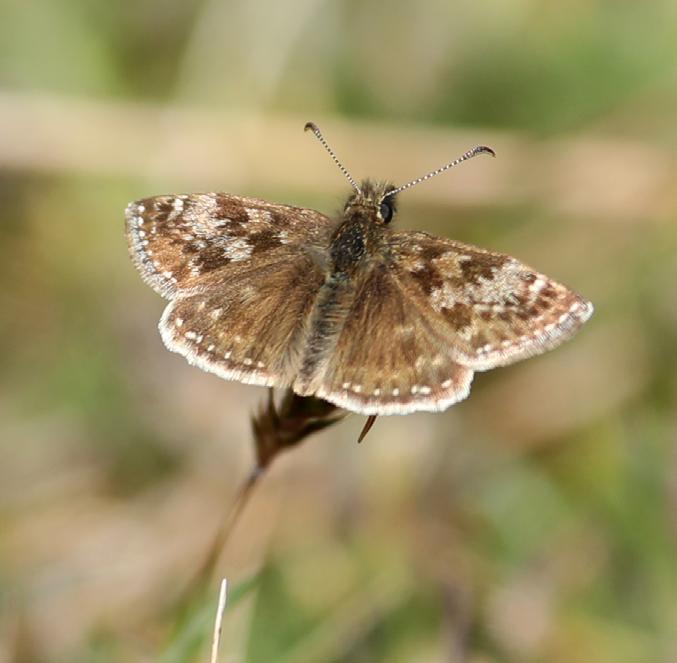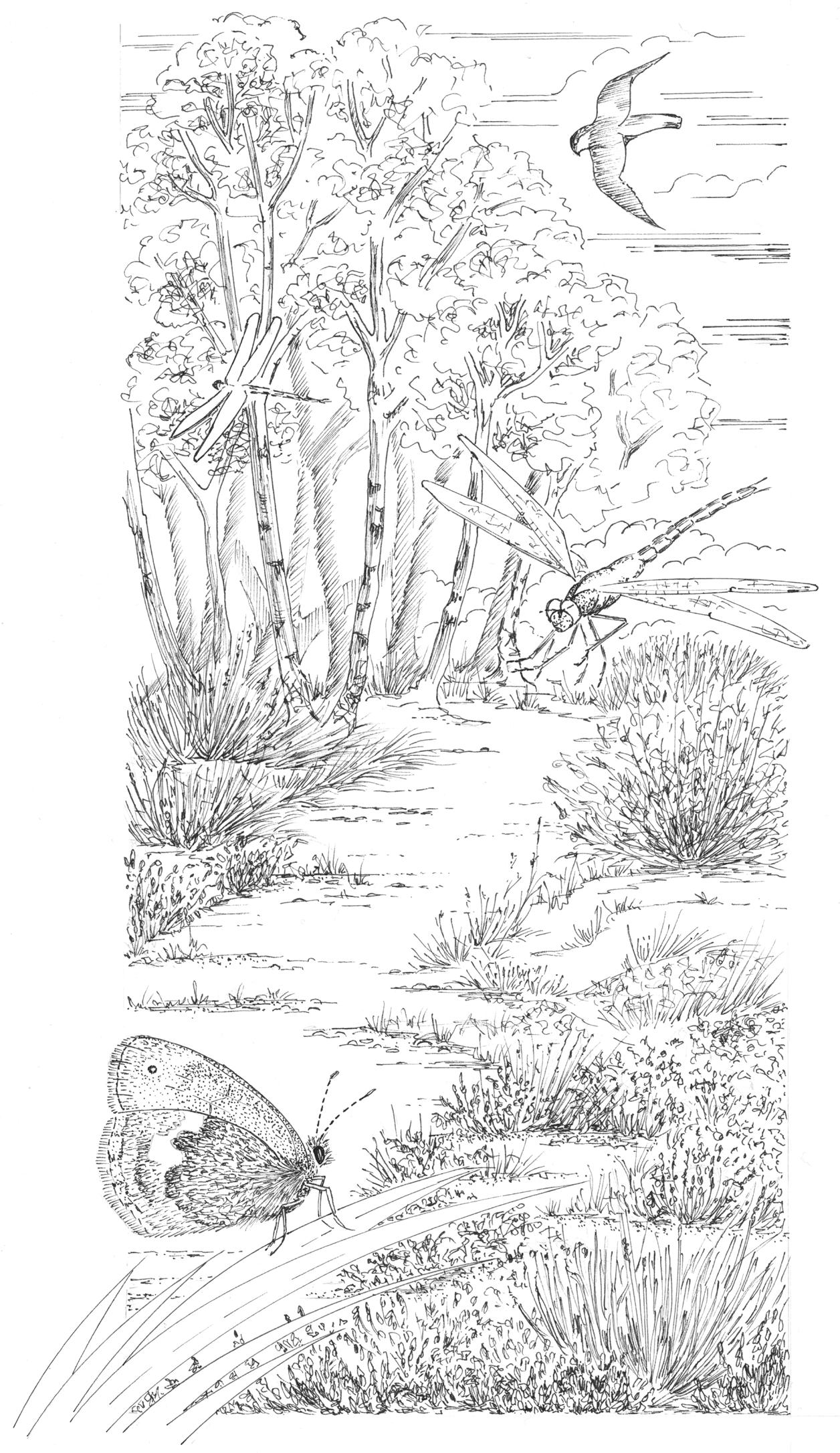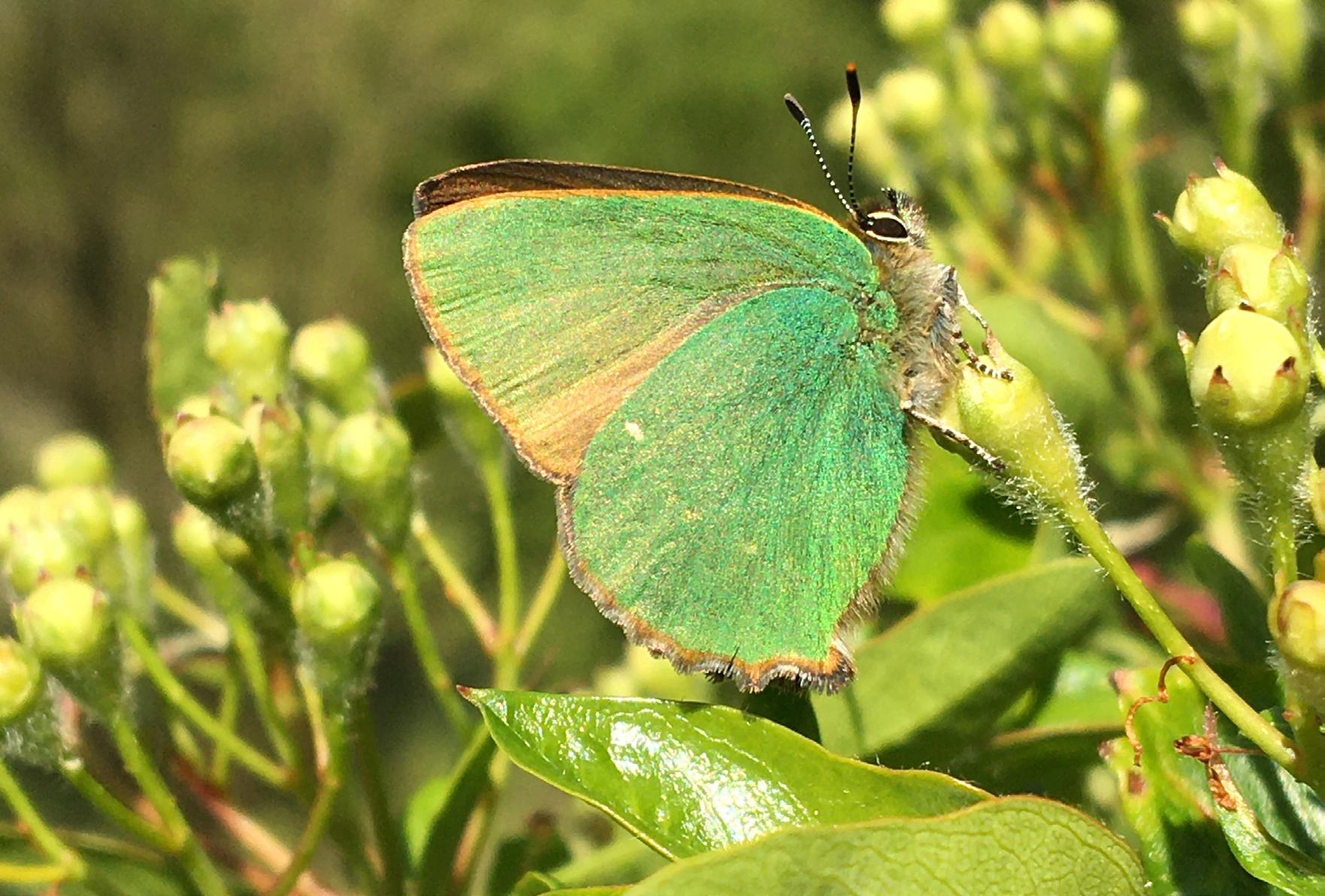
20 minute read
BAP species
44
Suffolk Butterfly Report 2019- BAP Species Annex E-Dingy Skipper

Dingy Skipper by Trevor Goodfellow
In 2019, the Dingy Skipper had been on the wing since 22nd April along the Devils Dyke in Cambridgeshire. Normally this butterfly flies in Suffolk some 7-10 days after the first Cambridgeshire sightings but any chances of an early appearance in Suffolk were reduced due to a fortnight of unsettled cool weather. The Dingy Skipper was, therefore, first seen in Suffolk in the Kings Forest on 15th May, the same date as in 2018. The butterfly was last recorded on 3rd June at Center Parcs, Elveden. The following is a summary of the survey work undertaken and sites visited. Surveys again focussed on the Kings Forest, NWT Thetford Heath, RAF Barnham and other key sites within the Suffolk Brecks. A good number of casual records were also received during the month on May to complement the planned surveying.
Summary of recording:
Location
Kings Forest- Archery/ Wordwell Kings ForestChalk Lane RAF Barnham, Thetford Center Parcs, Elveden Kings Forest- west of B1106 Kings Forest- North
Grid Reference
TL8272, TL8273, TL8372 and TL8473 TL8275, TL8375, TL8374 and TL8474 TL8680
TL8080
TL8174
TL8275, TL8276
Date
15th to 23rd May
16th to 24th May
19th May
21st May to 3rd June
21st May
24th May
Max No. of Dingy Skippers recorded
50
22
9
3
5
1
Disappointingly, and for the third year running this species was not recorded on or around NWT Thetford Heath but the butterfly was seen again in good numbers on adjacent MOD land at RAF Barnham with several copulating pairs observed. Importantly, Dingy Skippers were again seen during surveys of the Elveden Center Parcs wildlife mounds.
Given the casual records received and survey results, clearly, the butterfly flew in reasonable numbers throughout May in the Kings Forest. Additional effort was put into extending coverage north and west within the Kings Forest and this paid off with a few but important sightings being made.
Based on the records received in 2019 the distribution map below identifies the small area that the Dingy Skipper continues to cling on to in the Suffolk Brecks. In 2019, it was recorded in 8 tetrads, the same as recorded in 2018 but disappointing given the amount of additional targeted surveying undertaken.
The Kings Forest clearly remains the stronghold for the species in the county and numbers seen this year were slightly above average. It is also significant that the butterfly appears to have spread, albeit in small numbers, to other parts of the forest away from the favoured Wordwell and Chalk Lane areas. The butterfly has demonstrated its robustness and its ability to move short distances within the forest to colonise newly cleared areas especially where birds-foot trefoil can be found. However, given the continuing and significant forestry activity the species’ position continues to hang in the balance and requires constant monitoring. As referred to in the main report, section 6.1 Central Ipswich sightings, two records of Dingy Skipper were received from Landseer Park, Ipswich at the end of May. One butterfly was reported as barely able to fly, a second was photographed on birds-foot trefoil. It is presumed that these are released specimens. On a national basis the UKBMS Summary of Changes table show the Dingy Skipper was recorded as having an above average year with a 23% increase on 20187 records. That said, it remains of concern with a -22% decrease over the 10-year trend and -14% over the long-term series trend (43 years).
Annex F- Silver-studded blue

In 2019, the Silver-studded Blue was first seen on 9th June at Westleton Heath and last seen on 27th August at Black Heath. The graph below shows a strong peak at the end of June, and with a smaller second generation appearing towards the end of July.
Overall, the season appeared to be a poor one and down on 2018. Of note, the butterfly was only reported from 13 tetrads, a worrying fall from the 16 in 2018. Nationally, the UKBMS Summary of Changes show a disappointing percentage change of -22% from 2018 to 2019. The map below shows reported sightings for the county.


Map: Distribution of Dingy Skipper, 2019 Map: Distribution of Dingy Skipper, 2019
The Kings Forest clearly remains the stronghold for the species in the county and numbers seen this year were slightly above average. It is also significant that the butterfly appears to have spread, albeit in small numbers, to other parts of the forest away from the favoured Wordwell and Chalk Lane areas. The butterfly has demonstrated its robustness and its ability to move short distances within the forest to colonise newly cleared areas especially where birds-foot trefoil can be found. However, given the continuing and significant forestry activity the species’ position continues to hang in the balance and requires constant monitoring. As referred to in the main report, section 6.1 Central Ipswich sightings, two records of Dingy Skipper were received from Landseer Park, Ipswich at the end of May. One butterfly was reported as barely able to fly, a second was photographed on birds-foot trefoil. It is presumed that these are released specimens. On a national basis the UKBMS Summary of Changes table show the Dingy Skipper was recorded as having an above average year with a 23% increase on 20187 records. That said, it remains of concern with a -22% decrease over the 10-year trend and -14% over the long-term series trend (43 years).
Annex F- Silver-studded blue
In 2019, the Silver-studded Blue was first seen on 9th June at Westleton Heath and last seen on 27th August at Black Heath. The graph below shows a strong peak at the end of June, and with a smaller second generation appearing towards the end of July.
Overall, the season appeared to be a poor one and down on 2018. Of note, the butterfly was only reported from 13 tetrads, a worrying fall from the 16 in 2018. Nationally, the UKBMS Summary of Changes show a disappointing percentage change of -22% from 2018 to 2019. The map below shows reported sightings for the county.
Map: Distribution of Silver-studded Blue, 2019
This species remains vulnerable and suitable sites are few and far between. It is therefore incredibly concerning when a site is lost due to habitat change or damaged by fire. This happened at Martlesham Silver Studded Blue, Purdis Heath by Kev LingSSSI in September when a heath fire ravaged the land leading to several important butterfly areas being lost.


Map: Distribution of Silver-studded Blue, 2019 Map: Distribution of Silver-studded Blue, 2019 Map: Distribution of White-letter Hairstreak, 2019 Map: Distribution of White-letter Hairstreak, 2019
This species remains vulnerable and suitable sites are few and far between. It is therefore incredibly concerning when a site is lost due to habitat change or damaged by fire. This happened at Martlesham SSSI in September when a heath fire ravaged the land leading to several important butterfly areas being lost.
Annex G- White-letter Hairstreak
In 2019, the butterfly was first recorded on 18th May along the Icknield Way. This was significantly early, almost a month ahead of the main flight season and constituted a new earliest date for the county. The butterfly was last recorded on 12th August at Dunwich Forest. The maximum counts received were much lower than last year with several counts of 12 being the highest and all coming from the Dunwich Forest area. The map below shows the recorded coverage for the year with the butterfly being recorded in 51 tetrads. This is down 20 tetrads on 2018 although it must be remembered that 2018 was a significant year for the species given the long hot summer. If you compare 2019 to 2017, where the butterfly was seen in 38 tetrads then it can be considered a reasonable year overall. Within the county, the long-term trend (see Annex C) is still of concern with no real significant increases noted and I have described the WhiteLetter Hairstreak population as being “weak but stable. On a national level, the UKBMS Summary of Changes table reports the percentage change
between 2018 and 2019 as -39%, this is This species remains vulnerable and suitable sites are few and far between. It is therefore incredibly concerning when a site is lost due to habitat change or damaged by fire. This happened at Martlesham Within the county, the long-term trend (see Annex C) is still of concern with no real significant increases noted and I have described the White-Letter Hairstreak population as being “weak but stable. SSSI in September when a heath fire ravaged the land leading to several important comparable to what we have seen in Suffolk. From butterfly areas being lost. a long-term position, this species is described as On a national level, the UKBMS Summary of Changes table reports the percentage change between 2018 and 2019 as -39%, this is comparable to what we have seen in Suffolk. From a long-term position, this Annex G- White-letter Hairstreak suffering from a “very highly significant” fall in species is described as suffering from a “very highly significant” fall in abundance based on the UKBMS abundance based on the UKBMS 1976- 2017 trend period which reveals a fall in White-letter In 2019, the butterfly was first recorded on 18th May along the Icknield Way. This was significantly early, almost a month ahead of the main flight season and constituted a new earliest date for the county. The butterfly was last recorded on 12th August at Dunwich Forest. The maximum counts received were much 1976- 2017 trend period which reveals a fall in White-letter Hairstreak abundance of -79%. The White-letter Hairstreak remains a troublesome butterfly for recording purposes. Seeing the butterfly and accurately addressing the population of this species is difficult due to it invariably flying in the Hairstreak abundance of -79%. canopy of elms and neighbouring trees. It can also roam wide areas utilising elm hidden amongst roadside 3 hedgerows. It is, therefore, difficult to count away from known sites where established viewing positions The White-letter Hairstreak remains a are normally used. As identified above, locating additional sites is important for the future assessment of this species. Looking for elms in the spring is a useful method as they often get lost amongst other more troublesome butterfly for recording purposes. dominant trees as the canopy develops. These sites can then be recorded and returned to in the summer Seeing the butterfly and accurately addressing for accurate monitoring. 4 the population of this species is difficult due to it invariably flying in the canopy of elms and neighbouring trees. It can also roam wide areas utilising elm hidden amongst roadside hedgerows. It is, therefore, difficult to count away from known sites where established viewing positions are normally used. As identified above, locating additional sites is important for the future assessment of this species. Looking for elms in the spring is a useful method as they often get lost amongst other more dominant trees as the canopy develops. These sites can then be recorded and returned to in the summer for accurate monitoring.

Annex I- Grayling
Annex H- White Admiral
In 2019, despite an increase in recording coverage the Grayling was only seen in 46 tetrads, 8 less than in 2018. It was first seen on 5th July at Aldringham Walks and last seen on at 18th Annex I- September at Hazelwood Marshes, Aldeburgh. Grayling The highest count reported was only 50 on 29th In 2019, despite an increase in recording coverage the Grayling was only seen in 46 tetrads, 8 less than in 2018. July at Rendlesham Forest. Most “high” counts It was first seen on 5th July at Aldringham Walks and last seen on at 18th September at Hazelwood were between 10 and 20, significantly down on Marshes, Aldeburgh. The highest count reported was only 50 on 29th July at Rendlesham Forest. Most “high” counts were between 10 and 20, significantly down on previous years. previous years.
The map above shows the distribution recorded in the year and clearly shows the county divide and is representative of the Breckland habitat in the west of the county and the Sandlings habitat in the east. This species is now struggling in the county and appears to be losing its foothold in the west. Loss of habitat and intensification of farming methods along with misuse of pesticides have no doubt had a major impact on this specialist of heathland. 6 Nationally, the Grayling also struggled and the
UKBMS Summary of Changes table shows that it remains of concern with a -58% decrease over the 10-year trend and a highly significant -72% over the long-term series trend (43 years).
The map shows how restricted this species has become and that some focussed Grayling surveys will be required, particularly in the west of the county.

The White Admiral was recorded in 57 tetrads as opposed to the 66 in 2018. The map below shows the distribution of the species in the county in 2019.
Map: Distribution of White Admiral, 2019 Map: Distribution of White Admiral, 2019
Annex H- White AdmiralOverall, the White Admiral enjoyed only an average year in 2019. In recent years there has been a partial second generation, but this was not the case in 2019. The Summer generation flew from 23rd June The White Admiral was recorded in 57 tetrads as opposed to the 66 in 2018. The map below shows (Rendlesham Forest) until 8th August (RSPB Minsmere). Only one late record was received outside of this period on 22nd September at Free Wood, Bradfield St George. the distribution of the species in the county in 2019.
Overall, the White Admiral enjoyed only an average year in 2019. In recent years there has been a partial second generation, but this was not the case in 2019. The Summer generation flew from 23rd June (Rendlesham Forest) until 8th
August (RSPB Minsmere). Only one late record was received outside of this period on 22nd 5 September at Free Wood, Bradfield St George.
Despite the species appearing to be stable in the county, albeit, in low numbers the national 5 position is very different. The UKBMS Summary of Changes table 10-year trends indicate a -29% fall in abundance. As with the White-letter
Hairstreak, the White Admiral is also described as suffering from a “very highly significant” fall in abundance based on the UKBMS 1976- 2017 trend period which reveals a general fall in abundance of -61%.

Graph: Occurrence of White Admiral, 2019
Despite the species appearing to be stable in the county, albeit, in low numbers the national position is very different. The UKBMS Summary of Changes table 10-year trends indicate a -29% fall in abundance. As with the White-letter Hairstreak, the White Admiral is also described as suffering from a “very highly significant” fall in abundance based on the UKBMS 1976- 2017 trend period which reveals a general fall in abundance of -61%.

Map: Distribution of White Admiral, 2019
Overall, the White Admiral enjoyed only an average year in 2019. In recent years there has been a partial second generation, but this was not the case in 2019. The Summer generation flew from 23rd June (Rendlesham Forest) until 8th August (RSPB Minsmere). Only one late record was received outside of this period on 22nd September at Free Wood, Bradfield St George.
Graph: Occurrence of White Admiral, 2019 Graph: Occurrence of White Admiral, 2019
Map: Distribution of Grayling, 2019 Map: Distribution of Grayling, 2019
The map above shows the distribution recorded in the year and clearly shows the county divide and is representative of the Breckland habitat in the west of the county and the Sandlings habitat in the east. This species is now struggling in the county and appears to be losing its foothold in the west. Loss of habitat and intensification of farming methods along with misuse of pesticides have no doubt had a major impact on this specialist of heathland. Nationally, the Grayling also struggled and the UKBMS Summary of Changes table shows that it remains of concern with a -58% decrease over the 10-year trend and a highly significant -72% over the long-term series trend (43 years). The map shows how restricted this species has become and that some focussed Grayling surveys will be required, particularly in the west of the county.
Annex J- Wall
Over the last few years, we have seen the range of this beautiful butterfly diminish significantly in the county. It has continued its slide eastwards towards the coast and is now only recorded in two key locations: a small area around Orford/ Sudbourne and various sites throughout the Waveney Valley, particularly SWT Carlton Marshes. In 2019, the Wall was seen in 22 tetrads, pleasingly up 4 tetrads on
Despite the species appearing to be stable in the county, albeit, in low numbers the national position is very different. The UKBMS Summary of Changes table 10-year trends indicate a -29% fall in abundance. As with the White-letter Hairstreak, the White Admiral is also described as suffering from a “very highly significant” fall in abundance based on the UKBMS 1976- 2017 trend period which reveals a general fall in abundance of -61%.
2018. However, this good news is slightly tempered by the fact that maximum counts were in the main lower and most records of this species were of singletons. As in recent years, the vast majority of records are from the Waveney Valley area.

The Wall was first recorded in 2019 on 12th May at SWT Carlton Marshes and in Lowestoft. It was last seen on 5th October again at SWT Carlton Marshes. The best counts received were all from SWT Carlton Marshes with the highest being 11 on 8th August. Most records received away from SWT Carlton Marshes were of single butterflies. The map below highlights the accepted records received in 2019.
Wall brown by Robert Quadling
Annex J- Wall
Over the last few years, we have seen the range of this beautiful butterfly diminish significantly in the county. It has continued its slide eastwards towards the coast and is now only recorded in two key locations: a small area around Orford/ Sudbourne and various sites throughout the Waveney Valley, particularly SWT Carlton Marshes. In 2019, the Wall was seen in 22 tetrads, pleasingly up 4 tetrads on 2018. However, this good news is slightly tempered by the fact that maximum counts were in the main lower and most records of this species were of singletons. As in recent years, the vast majority of records are from the Waveney Valley area. The Wall was first recorded in 2019 on 12th May at SWT Carlton Marshes and in Lowestoft. It was last seen on 5th October again at SWT Carlton Marshes. The best counts received were all from SWT Carlton Marshes with the highest being 11 on 8th August. Most records received away from SWT Carlton Marshes were of single butterflies. The map below highlights the accepted records received in 2019.
Map: Distribution of Wall, 2019 Map: Distribution of Wall, 2019
A review of all the records received helps to identify the generations seen within the county. The graph A review of all the records received helps to below helps to show the first (12th May to 11th June) and second (17th July to 31st August) generations. A third 2018 identify the generations seen within the county. generation was again noted (11th September to 5th October), this being one week earlier than the 3rd generation but finishing some two weeks earlier. The graph below clearly shows the three The graph below helps to show the first (12th generations with the second being the stronger. May to 11th June) and second (17th July to 31st August) generations. A third generation was again noted (11th September to 5th October), this being one week earlier than the 2018 3rd generation but finishing some two weeks earlier. The graph below clearly shows the three generations with the second being the stronger.Graph: Generations of Wall, 2019 7


Graph: Generations of Wall, 2019 Graph: Generations of Wall, 2019
7 Sadly, the Wall continues its decline in Suffolk and this position is reflected throughout the UK and parts of Europe. The UKBMS Summary of Changes table shows the percentage change from 2018 to 2019 as -24% and the long-term series trend (1976-2019) as -87% decline. As such, this decline is classified as “very highly significant”. It is, therefore, essential that the county population is monitored very closely and both range and abundance recorded accurately.
Annex J- Small Heath
The Small Heath was recorded in 215 tetrads this year which represents a pleasant increase of 15 from the 200 in 2018. The first records came from several western sites on the 26th April which was relatively early and perhaps reflected the warm Spring. The maximum numbers recorded for the year was 51 at a site new Newmarket on 17th August. It was last reported on 30th September, finishing almost three weeks earlier than in 2018. The distribution above clearly shows the strongholds of this butterfly as the heaths of the Sandlings in the east of the county and of the Brecklands to the west. However, the butterfly continues to be seen in many new areas including, parks and gardens reminding us that it is highly adaptive and can be found in a variety of grassy habitats.
The increase in the Suffolk population seen in 2018 appears to have had a continuing positive impact on 2019 with a slight increase in abundance again being seen. This position is reflected nationally in the UKBMS Summary of Changes Table for 2019 which shows a +5% change in abundance on 2018. However, we cannot be complacent as the long-term trend for Suffolk is still “weak and vulnerable” and the UKBMS series trend (1976-2016) shows -50% for the Small Heath population and this fall in abundance is classified as being “very highly significant”.

Red Admiral by Beryl Johnson
The Red Admiral By R. Amor
‘A black smudge against a gilded green leaf Frill of creamy-white concentric rings Flutters of red stripes The arrival of its fleet heralding late summer ‘

Map: Distribution of Small Heath, 2019 Map: Distribution of Small Heath, 2019
The distribution above clearly shows the strongholds of this butterfly as the heaths of the Sandlings in the east of the county and of the Brecklands to the west. However, the butterfly continues to be seen in new areas including, parks and gardens reminding us that it is highly adaptive and can be found in a variety of grassy habitats. The increase in the Suffolk population seen in 2018 appears to have had a continuing positive impact on 2019 with a slight increase in abundance again being seen. This position is reflected nationally in the UKBMS Summary of Changes Table for 2019 which shows a +5% change in abundance on 2018. However, we cannot be complacent as the long-term trend for Suffolk is still “weak and vulnerable” and the UKBMS series trend (1976-2016) shows -50% for the Small Heath population and this fall in abundance is classified as being “very highly significant”.
8



Nemophora degeerella by Trevor Goodfellow Suffolk BC stand at SNS Conference




Orange Tip by Kev Ling Esperia sulpherella by Trevor Goodfellow

Orange Tip by Kev Ling







